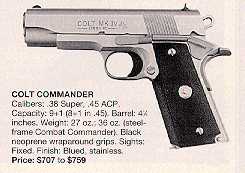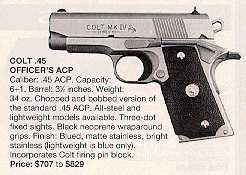The Colt Model 1911 was the product of a very capable person, namely John Moses Browning, father of several modern
firearms.
The pistol was
designed to comply with the requirements of the U.S. Army, which, during its
campaign against the Moros in Philippines, had seen its trusty .38 revolver
to be incapable of stopping attackers. An Ordnance Board headed by Col. John T. Thompson (inventor of the Thompson sub-machine-gun) and Col. Louis A. La Garde, had reached the conclusion that the army needed a .45" caliber cartridge, to provide adequate stopping power. In the mean time, J. Browning who
was working for Colt, had already designed an
autoloader pistol, around a
cartridge similar to contemporary .38 Super (dimension-wise).
When the Army announced its interest in a new handgun, Browning re-engineered this handgun to accommodate a .45" diameter cartridge of his own design (with a 230 gr. FMJ bullet), and submitted the pistol to the Army for evaluation.
In the selection
process, which started at 1906 with firearms submitted by Colt, Luger,
Savage, Knoble, Bergmann, White-Merrill and Smith & Wesson, Browning's design
was selected, together with the Savage design in 1907. However,
the U.S. Army pressed for some service tests, which revealed that neither
pistol (Colt's or Savage's) had reached the desired perfection. The
Ordnance Department instituted a series of further tests and experiments,
which eventually resulted in the appointment of a selection committee, in
1911.
Browning was determined to prove the superiority of his handgun, so he went to
Hartford to personally supervise the production of the gun. There he met
Fred Moore, a young Colt employee with whom he worked in close
cooperation trying to make sure that each part that was produced for the
test guns was simply the best possible. The guns produced were submitted
again for evaluation, to the committee. A torture test was conducted, on
March 3rd, 1911. The test consisted of having each gun fire 6000 rounds.
One hundred shots would be fired and the pistol would be allowed to cool
for 5 minutes. After every 1000 rounds, the pistol would be cleaned and
oiled. After firing those 6000 rounds, the pistol would be tested with
deformed cartridges, some seated too deeply, some not seated enough, etc. The
gun would then be rusted in acid or submerged in sand and mud and some more
tests would then be conducted.
Browning's pistols passed the whole test series with flying colors. It was
the first firearm to undergo such a test, firing continuously 6000
cartridges, a record broken only in 1917 when Browning's recoil-operated
machine gun fired a 40000 rounds test.
The report of the evaluation committee (taken from 'The .45 Automatic, An American Rifleman
Reprint', published by the National Rifle Association of America) released
on the 20th of March 1911 stated :
"Of the two pistols, the board was of the opinion
that the Colt is superior, because it is more
reliable, more enduring, more easily disassembled
when there are broken parts to be replaced, and
more accurate."
On March 29th, 1911, the Browning-designed, Colt-produced .45 Automatic pistol, was selected as the official sidearm of the Armed Forces
of U.S.A., and named Model 1911.

 That original pistol, was very similar
to the pistols produced today. One easily-distinguishable external difference is the crescent-shaped cuts, behind the trigger of the contemporary pistols, which were missing from the original design and were adopted later on, and which first appeared on model M1911A1. All the differences can be seen here.
That original pistol, was very similar
to the pistols produced today. One easily-distinguishable external difference is the crescent-shaped cuts, behind the trigger of the contemporary pistols, which were missing from the original design and were adopted later on, and which first appeared on model M1911A1. All the differences can be seen here.
The Colt Model 1911 was slightly improved in early 1920's when the flat
mainspring housing was replaced with an arched one (not a wise selection
according to my personal opinion), a shorter hammer spur was used, a short
trigger was made standard as well as a longer grip safety. The new model
was named Colt M-1911 A1 Government Model. In 1929, Colt also produced a 1911 pistol, based on the new .38 Super cartridge, while in 1931 a .22 LR version of the pistol was produced, named Colt Ace.
In this form, the gun was produced during the
remaining years until WW II, when military requirements were met by production of M-1911 by several firearms manufacturers such as Ithaca, Remington-Rand, Union Switch, Singer etc. Several thousands of this firearm were
produced during the war period.
After the war, the M-1911 was adopted by several armies around the world, as the standard sidearm. Greece, my home country was one of them. Also, Colt signed contracts with some manufacturers in those countries, to produce this model. Here, you can see some pictures of an Argentinian M-1911, send to me by an Internet surfer.
Recent History and Sizes



The same gun was produced after the war, with almost no changes
in the original Browning's design. Soon after the war, Colt introduced a new gun, based on the M-1911 A1 "Government" design, which was a shortened version of the M-1911 A1 pistol. This new gun featured a 4.25" barrel, (compared to the 5" of its prodecessor) and had an aluminum frame (for the first time this material was used in a handgun frame). The gun was called "Commander" (and not "Lightweight Commander" which was adopted later by Colt for this pistol) and was very well received by the public. In the years to come, Colt also produced the same pistol but with a steel frame, named "Combat Commander", and the term "Commander" has been used ever since to denote guns with 4.25" barrels. Still later on, Colt introduced a pistol with an even shorter barrel (3.50"), targeting the concealed carry users, called "Officer's", which also had a shorter frame, thus using 6 round magazines. Again, this model name, is used today to denote the smallest model versions, with shorter barrel and frames.
 In the 1980's Colt introduced a new series of all their models, with an
additional safety device, namely a firing pin safety, which didn't allow
the pistol to fire if the trigger wasn't pulled to the end of its
travel. The guns produced there after, are called Colt MKIV - Series 80.
This safety system (click here to view an enlarged diagram, or here to see a picture of the safety mechanism), although it was deemed necessary in today's world of
lawsuits, it is rumoured to have a bad effect on trigger pull (I personally haven't noticed this to be true). For this reason, it was
never widely accepted by expert shooters who want a decent trigger pull on their
firearms. A member of our Forums Site has posted this article for the Series 80 pistols, which explains in details, what fits what. This same firepin safety mechanism is also used in the high-capacity pistols, produced by Para Ordnance.
In the 1980's Colt introduced a new series of all their models, with an
additional safety device, namely a firing pin safety, which didn't allow
the pistol to fire if the trigger wasn't pulled to the end of its
travel. The guns produced there after, are called Colt MKIV - Series 80.
This safety system (click here to view an enlarged diagram, or here to see a picture of the safety mechanism), although it was deemed necessary in today's world of
lawsuits, it is rumoured to have a bad effect on trigger pull (I personally haven't noticed this to be true). For this reason, it was
never widely accepted by expert shooters who want a decent trigger pull on their
firearms. A member of our Forums Site has posted this article for the Series 80 pistols, which explains in details, what fits what. This same firepin safety mechanism is also used in the high-capacity pistols, produced by Para Ordnance.
During the nineties Colt announced their "Enhanced Series" of M-1911s, which were basically the Series 80 guns, with several modifications that most shooters would do on their pistols. Such modifications were a (sort-of) beavertail grip safety, beveled magazine well, flared ejection port, and a cut underneat the rear of the trigger guard, which allowed the pistol to sit lower in one's hand.
Of course, during the last two decades, several other manufacturers started producing M-1911 pistols. Some of them, just follow the traditional lines, while others are state-of-the-art, based on polymer frames etc. One thing is clear, John Browning's design is still alive and doing extremely well, after more than eight decades from its initial conception.
 The following real stories include the usage of an M-1911. They come from another excellent M-1911 Internet resource, namely "The Sight 1911A1". Each link in the table below, will open a new browser window, close it to return here.
The following real stories include the usage of an M-1911. They come from another excellent M-1911 Internet resource, namely "The Sight 1911A1". Each link in the table below, will open a new browser window, close it to return here.
Finally, one question frequently asked to me, is "Why an M-1911?". Well, here is Syd's answer! I couldn't say it better myself.

If you are interested in another excellent historical review, by another site, click here.
If you are interested in learning the history of Colt, the company which gave us this fine firearm, please click here.

 That original pistol, was very similar
to the pistols produced today. One easily-distinguishable external difference is the crescent-shaped cuts, behind the trigger of the contemporary pistols, which were missing from the original design and were adopted later on, and which first appeared on model M1911A1. All the differences can be seen here.
That original pistol, was very similar
to the pistols produced today. One easily-distinguishable external difference is the crescent-shaped cuts, behind the trigger of the contemporary pistols, which were missing from the original design and were adopted later on, and which first appeared on model M1911A1. All the differences can be seen here.



 In the 1980's Colt introduced a new series of all their models, with an
additional safety device, namely a firing pin safety, which didn't allow
the pistol to fire if the trigger wasn't pulled to the end of its
travel. The guns produced there after, are called
In the 1980's Colt introduced a new series of all their models, with an
additional safety device, namely a firing pin safety, which didn't allow
the pistol to fire if the trigger wasn't pulled to the end of its
travel. The guns produced there after, are called  The following real stories include the usage of an M-1911. They come from another excellent M-1911 Internet resource, namely
The following real stories include the usage of an M-1911. They come from another excellent M-1911 Internet resource, namely 